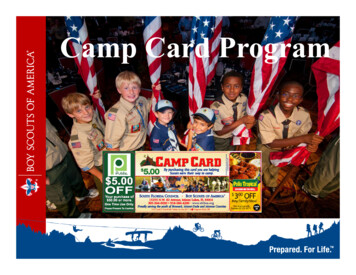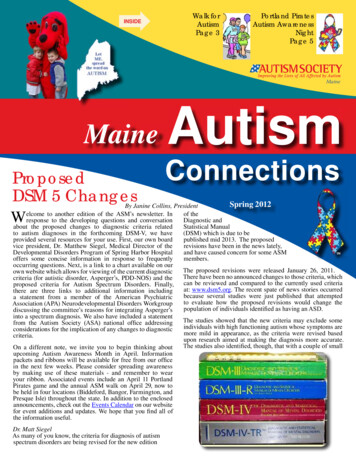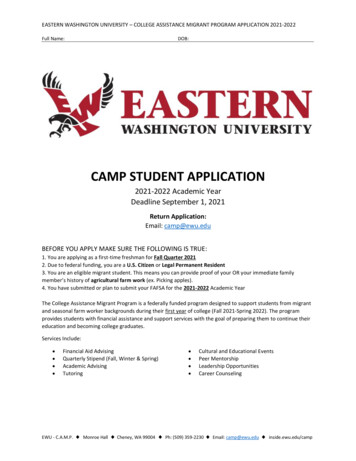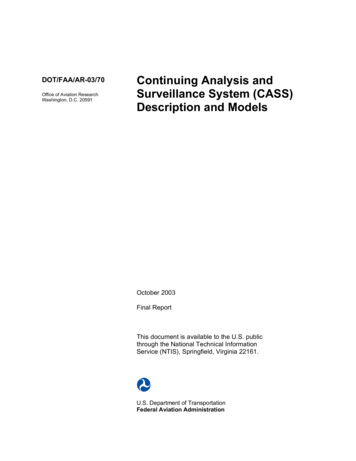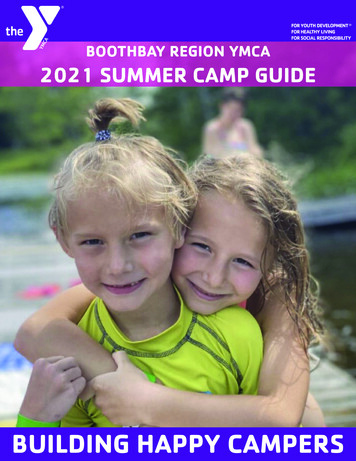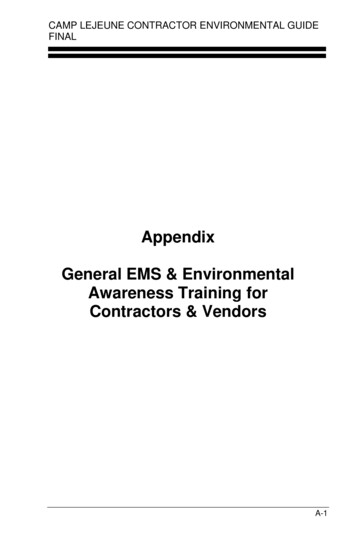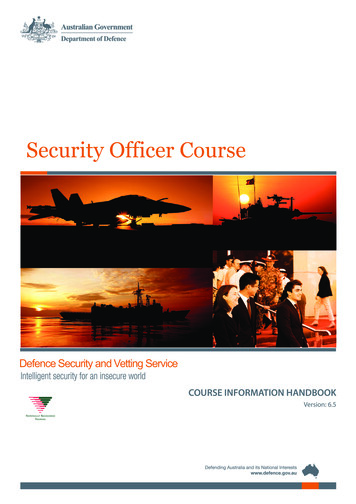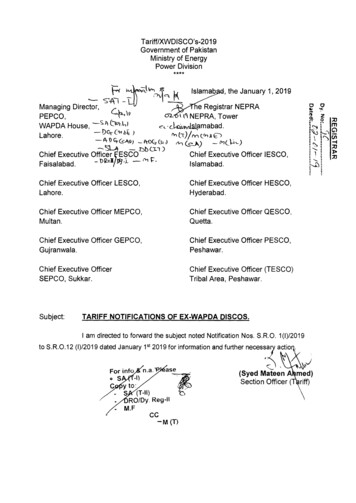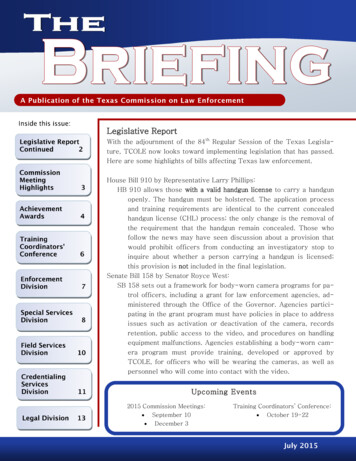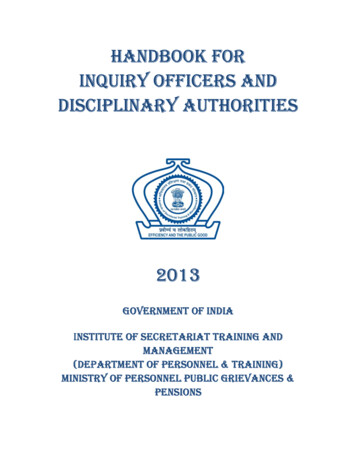
Transcription
CAMP HEALTHOFFICERTRAININGDay Camp & Short-Term Camps
Outline Introduction to this TrainingWho you will work with as the Camp Health Officer(CHO) at a Day Camp or Short-Term Camp.Overview of your roleQualifications, duties and expectations Managing the health area Duties before camp Duties during camp Duties when closing campQuiz
Introduction: Why take this training? All Boy Scouts of America camping is conducted using carefully writtenstandards. These standards are revised annually and published as theNational Camp Accreditation Program’s National Camp Standards, (BSA No.430-056). They guide camps in their participation in the National CampAccreditation Program (NCAP) conducted by the Boy Scouts of America. These standards establish the basis for a safe and healthy camp. NCAP Standard SQ-405 requires you to take this CHO training. These standards have a number of critical policies and procedures thatdirect your work and that of all those involved in all types of Scoutcamping.
Introduction: What you will learn When “camp” is referenced, it refers to either your day camp(s) or shortterm camp(s), depending on the camp type you will work with. This training course will introduce you to the camp environment and to yourrole as the Camp Health Officer—one of the most critical roles in camp. This course will help you understand some of the important steps inproviding adequate health and safety in the camp environment.
Objectives of Camp Health Officer TrainingAt the end of this training course, you should: Understand the duties and responsibilities of the camp health officer—before, during, and after camp. Be able to implement the policies, procedures, and reference materials youneed to fill your role. Understand the requirements for recording and reporting injuries andillness, which are also part of your role.
Who you may work with as theCamp Health Officer Council Enterprise Risk ManagementCommitteeCouncil Health SupervisorCamp Director or Event Coordinator/ChairpersonCamp or Event Staff / VolunteersShort-Term Camp Administrator (this person may also be serving asthe camp director/ event coordinator/ chairperson)
Council Enterprise Risk ManagementCommittee The Council Enterprise Risk Management committee (ERM) works withcouncil staff to provide guidance, oversight, policy, and procedures forthe operation of all types of camp health operations at Day Camps andShort-Term Camps. How the ERM helps the Camp Health Officer: The ERM committee is a vital resource for the Camp Health Officer andmay be called upon for assistance.
Council Health Supervisor (CHS) Medical care and health supervision at the camp is under the direction of the CouncilHealth Supervisor (CHS). The CHS is a licensed physician and is a member of the ERMcommittee. Refer to NCAP Standard SQ-405.How the CHS helps the Camp Health Officer: The CHS is available to support the needs or concerns of the Camp Health Officerthroughout the camp/event. The CHS provides written instruction (standing orders) for the Camp Health Officer tofollow. See NCAP Standard HS-505. The CHS will have approved all policies, procedures, and supply/equipment lists beforecamp begins.
Camp Director or Event Director/ Chairperson Like the CHS, this individual will be available to support the needs or concerns of theCamp Health Officer.Short-Term Camp Administrator This individual will be available as a resource to support the Camp Health Officer. Thisperson may also be service as the camp/event chairperson.Camp / Event StaffCamp/Event Staff/Volunteers support camp health & safety. But you are ultimately responsible for tracking their health and safety (such as with precamp medical screening) and encouraging them to assist with maintaining overall camphealth and safety. Everyone is responsible for camp health and safety!
Overview: Qualifications of theCamp Health Officer (CHO) All medical care is under the direction of the Council Health Supervisor.At the minimum, the CHO must be CPR and AED certified from a nationally recognized provider, have completed this CampHealth Officer’s Training course, be at least 18 years of age, is on the camp property when staff or participants are present,and is on call at all times. Refer to NCAP Standard SQ-405. The CHO scope of practice depends on their qualifications (EMT, RN, MD, etc.). These qualifications must be appropriatefor the nature of the camp and its proximity to an emergency medical system (EMS). When access to EMS is less than 10 minutes, the CHO must be certified in American Red Cross Standard First Aid andCPR/AED for Professional Rescuers and Health Care Providers, or equivalents from a nationally recognized provider. When access to EMS is greater than 10 minutes, the CHO must be licensed as a physician, nurse practitioner, nurse(RN, LPN, or LVN), physician assistant, paramedic, emergency medical technician (basic, intermediate, or paramedic),licensed or registered emergency medical responder. Nurse’s aides, Certified Nursing Assistants (CNAs), and assistantsdo not qualify. When access to EMS is greater than 60 minutes, the Camp Health Officer must also have current certification inAmerican Red Cross Wilderness and Remote First Aid, or equivalent.
Overview: Preparing to serve as theCamp Health Officer (CHO) This training is the first step to being prepared as a CHO.At the end of this training, review the items on the resource lists at the end of thispresentation, including the relevant National Camp Standards.Review policies, procedures, and other documents or checklists that have been developedfor your camp.Review the standing orders (signed by the Council Health Supervisor) prior to the start ofcamp. Refer to NCAP Standard HS-505 and HS-506.
Overview: Duties and Expectations This role has a number of critical responsibilities:– As the CHO, your overarching focus must be on the prevention of injuries and thepromotion of health and safety.– You need to ensure that all the camp/event staff/volunteers are ready to respond toan emergency.– Your role throughout the camp will be to: Meet the immediate medical needs of those in camp Maintain health logs Maintain appropriate records of care Assist with filling out incident reports (if any) Perform medical screenings following the procedures outlinedin NCAP standard HS-504.
Duties and Expectations, cont. No one person can ensure that a camp is run in a healthy and safe manner.Consequently, health and accident prevention takes a team effort: everyleader, volunteer, professional, and council employee needs to be part ofthis team.As the Camp Health Officer, work with everyone to make this happen!
Duties and Expectations, cont. One of your most important duties will be to ensure that your team—othercamp/event staff and volunteers—is ready to respond to an emergency.Pay close attention to the safety elements of each area leader’s role and tosituations that affect the welfare of the camp.Everyone should model safety practices and skills to the youth and adultleaders at camp. You should be prepared to support them in these activities.General camp safety practices are a concern of all staff members, and you arekey to the team that will evaluate risks, provide training, and assist inenforcing health and safety rules that will affect everyone in camp.
Duties and Expectations, cont. Depending on state laws and your qualifications, below are some activities that may be part of completing theseduties. Camp health operations include scope of care; procedures for the health lodge/first-aid station; operatingpractices (such as hours of service, emergency care, standard orders, and provision of first-aid kits, AEDs, etc.) Camp treatment procedures (standing orders) should delineate what is treated at camp and how, when EMSshould be used, and procedures for any emergency medications and equipment that may be used by qualifiedstaff. EMS services procedures for calling, contact information, and providing orientation to the EMS services providingservice to the camp. Equipment and supplies needed for camp including verifying expiration dates, discarding expired medications andsupplies, maintaining medications at camp, and maintaining AEDs. Health screening for participants and staff. Medication management including administering, storing, and securing them. Sanitation of health facilities with procedures for dealing with contaminated waste and sharps. Selection and maintenance of camp first-aid kits.
Duties and Expectations, cont.– Maintain daily records of all first-aid and medical treatments (written in ink)—kept in the First Aid Log for–––Council/District Activity or Event, No. 680-127WB, maintained separately for campers and for staff members. SeeNCAP Standard HS-507.Review the First Aid Log with the Camp Director/Event Director or Chairperson at least once during the camp, todetermine trends to be analyzed and any corrective actions to be taken.All injuries, illnesses, and incidents beyond basic Scout-rendered first aid are reported promptly following BSAincident reporting requirements. The Camp Health Officer should immediately inform the Camp Director of all suchoccurrences. The CHS should also be notified as soon as possible. In the event of a fatality, communicable diseaseoutbreak, or other serious incidents the Scout Executive must report the event as soon as reasonablypossible. Protocols are outlined in NCAP Standard AO-808. In the event of a fatality or catastrophic injury orillness, the Camp Director is generally the incident commander with the Camp Health Officer providingemergent care until help arrives.At the close of the camp, all First Aid Logs are submitted to the council for record keeping; and incident reports aremade available to the Enterprise Risk Management committee for review.
Duties: Managing the Health / First Aid Area Depending on the camp, you may be responsible for the management of thecamp’s health / first aid area.Typical expectations for managing a camp health / first aid area are on thefollowing slides.Because every camp is unique, be sure to discuss with the CHS what yourresponsibilities for the health / first aid area will be.
Managing the Health / First Aid Area, cont. If you are responsible for the management of the health/first aid area, this will beone of your most important duties. The purpose of the camp health/first aid area is to provide a comfortable, quiet,private, and properly equipped place to give temporary care to ill or injuredcampers. The health/first aid area should be located conveniently near the central part ofcamp but far enough away from other facilities to provide privacy. It should belocated so that transport from a remote area or transport by EMS out of camp ispossible. A health/first aid area with good signage that is conveniently located helpsencourage campers and others to report promptly for first-aid treatment.Refer to NCAP Standard HS-509.
Managing the Health / First Aid Area, cont. The health/first aid area should be neat and clean and as attractive as campingconditions will permit.The surroundings should be pleasant for those who are in the health/first aid area.Depending on the facilities available, you could have a building, or it may be only agood tent with a canopy. Refer to NCAP Standard HS-509 for a list of requirementsfor your health/first aid area. These should include available toilets, washing water,and drinking water; proper lighting; cots/beds and space for medical treatment; andprotection from outside elements. Refer to NCAP Standard HS-509.Whatever the physical arrangements, your job is to provide the best of care withinthose facilities.
Managing the Health / First Aid Area, cont. Youth protection requirements must be followed.– For example, if overnight care is anticipated, 2 deep observation, toileting,food and laundry must be provided.The equipment and supplies found in your camp health/first aid area werecarefully chosen and approved by the Council ERM and the Council HealthSupervisor based on their experience and feedback from prior camp healthofficers. Your feedback at the end of the camp will help guide them to makeimprovements based on your experiences.
Managing the Health / First Aid Area, cont. Avoid bringing and leaving unauthorized supplies, medications, and equipment orallowing others to do so. Well-intentioned “donated” supplies or equipment mayencourage and support a level of care inappropriate for future camp health officers orothers.However, you might consider bringing your own personal stethoscope and bloodpressure cuff if you are qualified to use them. The camp should provide you with aback-up, as well as personal protective equipment and other items as needed.As you arrive and begin opening the health/first aid area, familiarize yourself with theequipment provided and examine it often to ensure it remains in working condition.
Preparing for the Opening of Camp Now that you’ve read about the duties and expectations of the CHO, it’stime to get ready for your service in camp.Your personal preparation will be key to being prepared for what you maybe asked to do beginning your first day in camp.
Before Camp OpensIf possible, take a tour of the camp and be sure you can find your way around—even in the dark. Begin your hazard and health surveillance before campers arepresent. Issue or update (such as checking for expired medications) any first-aid kits thatwill be utilized by the camp. Refer to NCAP Standard HS-510. If the camp has one, place (or verify the location of) the camp’s AEDs and ensurethat they are working and complete (e.g., unexpired pads and batteries).
Before Camp Opens, cont. You may have several tasks to complete to make sure the camp health/first aidarea is ready.This could include:– Organizing and setting up the health/first aid area– Inventorying and cleaning the health/first aid area—inside and around thegrounds– Ensuring that all forms, policy manuals, phone lists, and other resourcematerials are in place and current.Know and be able to implement the camp’s written emergency procedures(described next). Refer to NCAP Standard AO-805.
Before Camp Opens, cont.Your camp has emergency action plans specific to the camp and the hazards that havebeen identified. Emergency action plans include detailed instructions for dealing withfires, serious illnesses, accidents, and fatalities. Refer to NCAP Standard AO-805. You are an important part of these plans. Before the first day of the camp, review the plan and understand your role as theCamp Health Officer so that you can move quickly when faced with an emergencysituation. Review common health threats present at your camp, such as sprained or brokenbones, poisonous plants, heat/cold injuries, drowning and concussions.
Before Camp Opens, cont. You should specifically review the camp plan on how to handle serious accidents andsituations including:– Evacuation of possible back or neck injuries– Serious illnesses– Fatalities– Camp crises such as active shooters, food poisoning, fire, flood, windstorm, searchfor a lost person, and outbreak of an apparent contagious diseaseThis plan and your planned response should be known and maintained in the camphealth/first aid area and included in your policies and procedures.
Before Camp Opens, cont. Check with the camp organizers to ensure that contact has been made with offcamp referral agencies such as the local nonresident camp physician, council heathsupervisor, referral emergency rooms, local ambulance service, paramedics orEMTs, and local police and fire departments.Work with local hospitals and ambulance services for the care and treatment ofpatients, including their rules and who the backups will be if they are unable toprovide service.
Before Camp Opens, cont. Find, update, and verify the emergency phone list including the Scout Executive, Camp orEvent Director and Council Health Supervisor. Refer to NCAP Standard AO-807.As a minimum, the list should include the following:– Firefighters– Police (state, county, and local)– Hospital (Specify which local hospital is preferred by the council.)– Emergency medical services (rescue squads and ambulances)– Physicians (More than one listing is advised.)– Mental Health Professionals
Before Camp Opens: UnderstandHow to Manage Medication UseThe BSA’s guiding principles for the safe use of medications include (Refer to NCAP StandardsHS-504-508): All medications are the responsibility of either the individual taking the medication or thatindividual’s parent or guardian.An adult leader, after obtaining all the necessary information and permission, can agree to accept theresponsibility of making sure a youth takes the necessary medication at the appropriate time, but theBSA does not mandate or necessarily encourage the leader to do so.Your council will have specific policies regarding the administration of medications. Be prepared tofollow the plan for your specific council and camp type.State or local laws that are more limiting than camp policies supersede any BSA guidance and mustbe followed.
Managing Medication Use, cont. All prescription and nonprescription medications kept in the health/first aid area (includingthose needing refrigeration) must be stored in accordance with the state laws applicable toyour camp location. Refer to NCAP Standard HS-508.The health/first aid area should have provisions for lockable storage, including refrigeratedmedications (required for day camps, suggested for short-term camps).Prescription medications stored outside the health/first aid area with the unit leader orother adult must be stored either under lock and key at the unit’s site or under directobservation by the adult.The only exception is for a limited amount of medication for life-threatening conditions,such as epinephrine auto injectors, heart medications and inhalers. These may be carried bya youth or adult member for personal use.
Managing Medication Use, cont. Read and understand the council’s policies and procedures for medicationmanagement.The procedures for medication management in camp should be reviewed withthe adult leaders in camp during leader orientation.Review NCAP Standard HS-508.
Before Camp Opens: You may have a role in pre-camp planning.You may help the camp organizing committee to provide:– Information on the importance of operating the camp so that the number ofaccidents and illnesses is minimal and that positive mental health practices arepromoted. Risk assessment and prevention is essential.– General operating rules of the health/first aid area (hours, how and when firstaid should be rendered at the site of injury vs. having it performed in thehealth/first aid area etc.)– Remember: health and safety takes a team effort!
Before Camp Opens: You may identify and train selected staff members to assist in the staffmedical screening process as needed.Know who else in camp has knowledge or skills that may be needed in anemergency.
Duties During CampNow that you’ve prepared for camp, it’s time to deliver the best campingexperience possible. Camp will be busy, and you will find your days filled with several specifictasks and opportunities to create a safe and healthy experience foreveryone in camp. Your day-to-day activities and duties will include those tasks discussed onthe next few slides.
During Camp: Overview During camp, your duties may include any and probably all of the following:– Depending on council policy for your camp, You might conduct medical screenings. Refer to NCAP Standard HS-504 forday camp versus short-term camp guidelines. You might set up a medication dispensing plan. Dispense medications dailyand maintain records. Refer to NCAP Standard HS-508.– Treat in-camp injuries and illness. Refer to NCAP Standard HS-506.– Meet with the camp coordinators and adult leaders in camp.
During Camp: Screenings At day camps, each participant is given a medical screening by a qualified adult. At short-termcamps, this medical screening can either be done by the unit or the camp health officer. If thescreening is done by the unit leader, they must inform the camp health officer or designee ofcampers with limitations, special needs or life-threatening circumstances. Reasonable steps aretaken to maintain privacy. Refer to NCAP Standard HS-504.The screening must follow the established medical screening checklist provided by the CouncilHealth Supervisor.Regardless of who does the screening: The screening will generally seek to identify whether theindividual is healthy enough to participate in camp activities and how his or her health needs mayalter either their ability to participate or require some special attention by leaders or camp staff.
Screening, cont. Screening also serves to identify any health condition that is present on arrival that may affect others(e.g., communicable diseases, rashes) and to provide a general health status (e.g., feeling and lookingwell).Be careful to assure that:– Youth Protection guidelines are followed during screening.– The confidentiality of the health information of each camper and staff member is protected.Annual Health and Medical Records:–At Day Camp, at the conclusion of the screening, the CHO (you) takes possession of the participant’s Annual Health andMedical Record and maintains them according to established policies. Refer to NCAP Standard HS-503.–At Short-Term camp, participants’ Annual Health and Medical Records can be stored with their unit leader; or with thecamp health officer depending on the pre-determined policy of the camp. Health forms and permission forms must bekept in a secure location accessible to the unit leader and camp staff while the camper or adult leader is in attendance.Refer to NCAP Standard HS-503
Screening, cont. The camp health officer may need to call upon the unit leader or other adultfamiliar with the individual participants to identify special health needs,medical considerations, or limitations of activities.The screening process is an ideal time to identify other medical resources whoare in camp for the camping period and to obtain their agreement to contact(for example, a camper who is a RN).
During Camp: Informing After screening, the Camp or Event Director must be informed about camperswith limitations so that the appropriate staff members can be alerted if required.This information is shared only with the camp staff members who need to know,and they are instructed to handle this important information in a discreet andproper manner.
During Camp: Deliver Care Open the health/first aid area and deliver care, both when needed and duringregular predetermined timeframes. Identify those who need care beyond what can be provided at camp andarrange for transportation and off-site treatment. It is critical that everyone practices within their scope of practice (e.g.,EMT, RN, MD, etc.). All care must be within the scope of the written council/camp medical carepolicies and procedures. (These policies should be reviewed by the CHS and ERMannually.) Refer to NCAP Standard HS-506.
During Camp: Deliver CareOther related responsibilities include: Maintaining the First Aid Log by entering all treatments. Refer to NCAP StandardHS-507. Maintaining the system for using and protecting the health records that allows foreasy access and privacy. Refer to NCAP Standard HS-507. Assisting campers who have stored their medication at the health/first aid area.
During Camp: Review and Analyze On an ongoing and constant basis, review the First Aid Log for trends. Immediately notifythe Camp Coordinator or event chairperson if issues such as outbreaks of illness orrepeated injuries in an area are identified. Depending on the issue, you may need tonotify others, such as the Council Health Supervisor or the local health department.At least once during the camp (or more frequently if needed), review the camp First AidLog in depth and discuss it with the Camp/ Event Director. Refer to NCAP Standard HS-507.– This review should include an analysis of incidents and accidents to determine if anyspecial attention, program changes, or training is needed.– Share this analysis on request with the rest of the staff. Be sure to maintain camper andstaff confidentiality when discussing incidents or accidents.– Ensure that corrective action items are established as a result of this review.
During Camp: Look, Listen & Talk Follow up with the unit leaders on reporting cases of injury or illness in theirunits. While maintaining privacy as much as possible, be sure they are beingnotified of injury/illness—especially if follow-up or observation is needed.Attend adult leader meetings to provide feedback, encourage healthybehaviors, and communicate known trends in camp. As you live and work in camp, make it a daily habit to move about thecamp. Perform routine health and safety surveillance of the camp andthe programs to include food, water, and facilities.
Look, Listen & Talk, cont. As you move about camp, look for processes and situations that can be made better andmay require intervention by you or others. These may include:– Overall sanitation– Proper hand washing by kitchen staff and campers– Personal health and cleanliness– Safety of equipment and grounds– Availability of first-aid kits and protective equipment
During Camp: Document and Report Proper recording and reporting is critically important!The First Aid Log for Council/District Activity or Event, No. 680-127WB may be usedfor day camp and short-term camps.Each entry should be printed clearly, including the date, the time of day, the legalname of each person seen, a brief summary of the injury or complaint of illness, anycontributing factors causing the injury or illness, and management plan.
Document and Report, cont. Each treatment (such as "bandaging a wound") or disposition (such as “Sent to hospital” or“Sent home”) must be entered on the same line and initialed by the person authorizing orhandling the disposition or treatment.The logbook must also reflect situations in whichan accident victim is taken directly from an accident scene to a hospital or private clinicrather than to the health/first aid area.An entry that an Incident Information Report was completed and that it was transmitted tothe camp /event director or other authorized employee for reporting should also be made.
Document and Report, cont. Specific examples of how to make correct entries are shown on the next slide.Because of employee reporting requirements, there must be two separatelogbooks: one for camp staff and one for campers.
Document and Report: Sample entries in theFirst Aid Log
Document and Report, cont. Reporting and handling of a fatality or serious injury or illness are to be treatedwith the utmost of care by a team—not by the Camp Health Officer actingalone! Refer to NCAP Standard AO-808. Inform the Camp /Event Director as soon as possible after the injured personhas begun receiving care.
Document and Report, cont. Because some camp staff maybe employees, special reporting requirements existfor employees.Any accident resulting in the death of an employee must be reported by the council(the employer), either verbally or in writing, to the nearest OSHA office or via 1-800321-OSHA (6742) or online within 8 hours of the accident.Any accident requiring a work-related in-patient hospitalization, amputation or lossof an eye by an employee must be reported within 24 hours.All of this special reporting will be done by your Scout Executive or their designee.This is not the responsibility of the Camp Health Officer.
Document and Report, cont. If a fatality or serious illness or injury occurs during the camping operation, theCamp Health Officer should immediately contact the Scout Executive.The Camp Health Officer should retain a copy of the Annual Health and MedicalRecord of the affected person.A copy of the completed Incident Information Report should be attached to thatform.The Incident Information Report and the Annual Health and Medical Recordshould be transmitted to the council office in accordance with the timelinesoutlined in NCAP Standard AO-808.
Document and Report, cont. The council office will maintain the records according to the approved BSA recordsretention policy.The First Aid Log and other records will be used by the Council Health Supervisor and thecouncil Enterprise Risk Management committee to prepare for future camping events.Injury and illness logs for BSA employees and camp staff must be available whenrequested by the Bureau of Labor Statistics or a state agency.Again, two separate logbooks must be maintained:– one for camp staff and BSA employees and– one for people attending camp.
Duties at the End of Camp:Closing Camp As with opening the camp, the end of the camp brings another list of important activities:– Complete the checklist for closing the health/first aid area. The checklist will focus on storing thesupplies and equipment, cleaning up for the next event/camp, and dealing with the paperworkyou’ve accumulated.– Prepare a brief report that summarizes events, activities, and recommendations for futurecamps. The report should be submitted to the Camp/Event Director for transmittal to the CouncilEnterprise Risk Management Committee.– Give all incident reports, medical records, and logbooks to the Camp Director/ Event Director orthe event’s staff adviser.– Consult with the Camp Leadership team for any other tasks.
Review QuestionsTake time to review the material we have covered.Write down your answers to the followingquestions.
Review QuestionsQuestion 1: True or false?The camp health officer reports to the Camp / Eve
licensed or registered emergency medical responder. Nurse’s aides, Certified Nursing Assistants (CNAs), and assistants do not qualify. When access to EMS is greater than 60 minutes, the Camp Health Officer must also have current certification in American Red Cross

